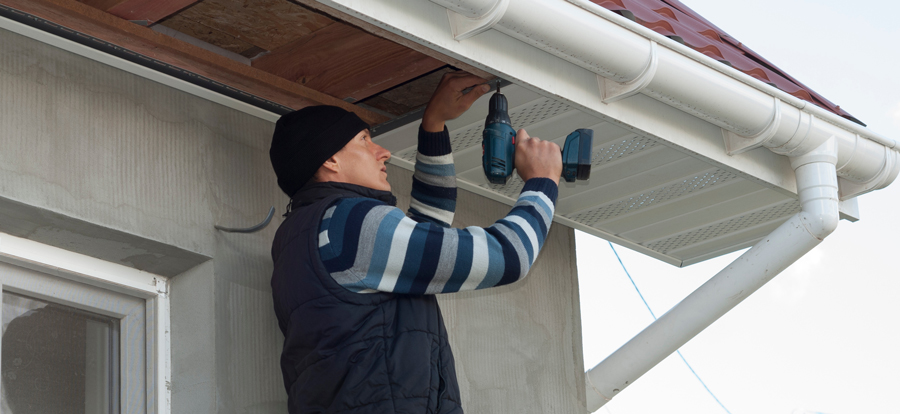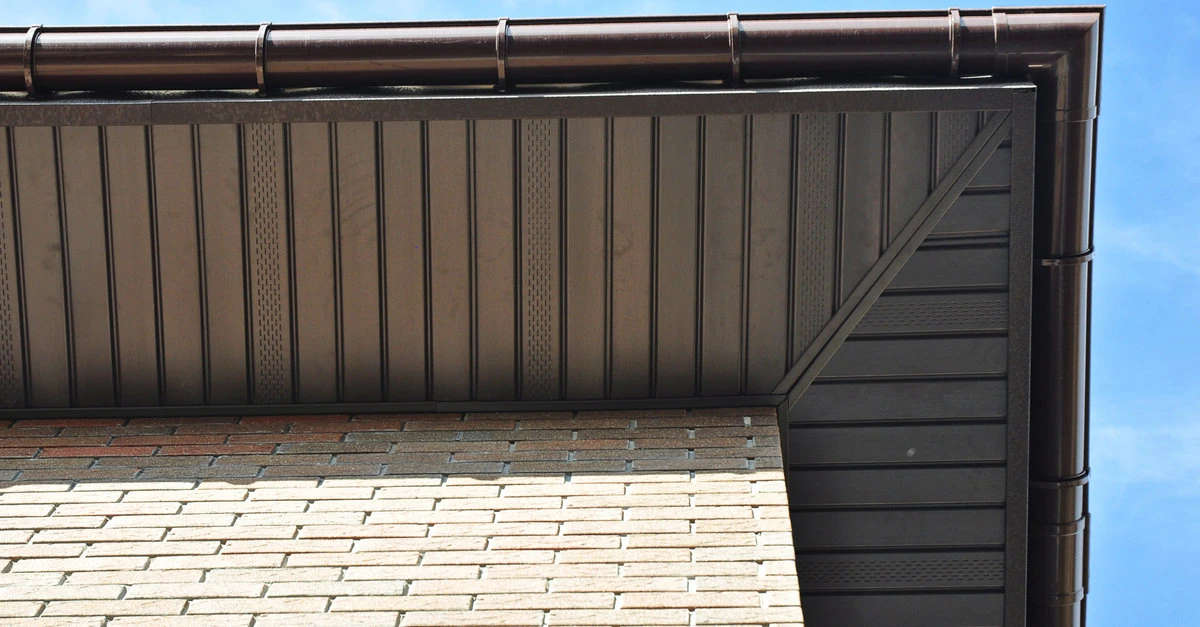Metal soffit installation consists of attaching metal panels under the eaves, providing protection and aesthetic appeal. This installation enhances the durability and appearance of a building.
Metal soffit installation is a crucial aspect of building construction. It involves attaching metal panels beneath the eaves to protect the underlying structure from moisture and weather elements while also improving the building’s overall look. Once installed correctly, metal soffits offer long-lasting performance and require minimal maintenance.
It is essential to follow proper installation techniques to ensure the soffit meets building codes and provides the desired functionality. With the right tools and expertise, this process can be accomplished efficiently, resulting in a functional and visually appealing addition to any structure.
Choosing The Right Material
When deciding on metal soffit installation, choosing the right material is crucial. Two popular options to consider are aluminum and steel. Each has its benefits and considerations to take into account.
Aluminum Vs. Steel
Aluminum:
- Lightweight and easy to work with
- Resistant to corrosion
- Available in various colors and finishes
Steel:
- Durable and strong
- Can withstand extreme weather conditions
- Potentially more cost-effective in the long run
Soffit Ventilation Options
Proper ventilation is essential for the longevity and effectiveness of your soffit. Consider these soffit ventilation options for optimal airflow:
- Soffit Vents: Allow air to flow into the attic space
- Vented Soffit Panels: Provide a continuous vented surface
- Eave Vents: Install at the eaves for improved airflow

Credit: readmetalroofing.com
Measuring And Preparation
Before metal soffit installation, proper measuring and preparation are essential to ensure a seamless process and a professional finish.
Taking Accurate Measurements
- Use a tape measure to measure the length and width of the soffit area.
- Ensure to account for any corners or angles by measuring each section individually.
- Double-check all measurements to avoid any mistakes during the installation process.
Preparing The Work Area
- Clean the soffit area thoroughly to remove any dirt, debris, or old material.
- Ensure the surface is smooth and flat by sanding down any rough spots or bumps.
- Remove any obstacles or obstructions that may hinder the installation process.
Tools And Equipment
When it comes to metal soffit installation, having the right tools and equipment is crucial for a successful and hassle-free process. Properly equipping yourself with the necessary items ensures efficiency and safety throughout the installation. In this section, we will outline the essential tools for the installation as well as the important safety gear that should be prioritized.
Essential Tools For Installation
- Metal soffit panels – This is the main material for the soffit installation, and it’s important to have the correct panels for your specific project.
- Stud finder – To locate and mark the studs on the ceiling, enabling you to secure the soffit panels properly.
- Tape measure – For accurate measurement of the soffit area and the panels that need to be cut to fit.
- Fasteners – Including screws or nails specifically designed for metal soffit installation to secure the panels in place.
- Cutting tools – Such as tin snips or a power saw capable of cutting through metal, for resizing soffit panels as needed.
- Level – Essential for ensuring the soffit panels are installed exactly straight and level.
- Drill and driver – For creating pilot holes and securing the fasteners into place.
- Caulk and sealant – To seal joints and edges where necessary for added weatherproofing and aesthetics.
Safety Gear
- Safety glasses – Protect your eyes from debris and metal particles during cutting and installation.
- Gloves – Ensure a secure grip and protect hands from sharp edges and potential injury.
- Hard hat – Necessary to safeguard against any falling objects or accidental knocks to the head.
- Ear protection – Noise-canceling ear defenders recommended during power saw operation or any loud construction activities.
- Work boots – Sturdy footwear to protect feet and provide stability on the work surface.
- Respirator mask – For protection against dust and fumes generated during cutting and installation processes.
Installation Techniques
When it comes to metal soffit installation, proper installation techniques are crucial to ensuring a successful and long-lasting result. This section will explore the key installation techniques you need to know to achieve a professional finish.
Proper Fastening Methods
In order to securely install metal soffits, it’s important to follow proper fastening methods. This ensures that the soffits will stay in place and withstand various weather conditions. Here are some important techniques to keep in mind:
- Use corrosion-resistant fasteners: When installing metal soffits, it’s important to use fasteners that are resistant to corrosion. This prevents any potential damage to the soffits over time.
- Follow manufacturer’s guidelines: Each metal soffit manufacturer may have specific guidelines for fastening methods. Make sure to carefully read and follow these instructions to ensure proper installation.
- Space fasteners evenly: Distributing fasteners evenly along the soffit panels helps to prevent any sagging or warping. Aim to place fasteners approximately 12 to 16 inches apart for optimal support.
- Pre-drill holes: To prevent any potential damage to the metal soffits, it’s advisable to pre-drill holes before inserting the fasteners. This allows for easier and more precise installation.
Dealing With Obstacles
During metal soffit installation, you may encounter certain obstacles that require special attention. Here’s how to overcome common obstacles:
1. Eaves and Fascia: When dealing with eaves and fascia, proper measurement and cutting are essential. Ensure that the metal soffits are cut with precision to fit snugly against these areas.
2. Ventilation systems: It’s important to ensure adequate ventilation when installing metal soffits. Take into account any existing ventilation systems and make necessary adjustments to maintain proper airflow.
3. Electrical wiring: If there are electrical wires in close proximity to the soffits, it’s crucial to handle them with care. Insulate the wires properly and create a safe distance between the wires and the metal soffits.
4. Downspouts and gutters: When installing metal soffits near downspouts and gutters, ensure that they are properly aligned and have sufficient clearance. This helps to prevent any interference with the functioning of these drainage systems.
https://woodworkingadvisor.com/how-to-install-metal-roof-snow-guards/By following these installation techniques, you can ensure a seamless metal soffit installation that not only enhances the aesthetic appeal of your building but also provides long-lasting durability.
Finishing Touches
For a sleek and polished look, metal soffit installation provides the ideal finishing touch to your building exterior. It offers durability and low maintenance while contributing to a clean and modern aesthetic. With its seamless integration, metal soffit adds a sophisticated touch to any architectural design.
After installing metal soffit, it’s important to pay attention to the finishing touches to ensure a professional and seamless look. This includes sealing and insulation as well as proper maintenance tips. By implementing these steps, you can enhance the performance, durability, and aesthetics of your metal soffit installation.
Sealing And Insulation
Properly sealing and insulating the metal soffit is crucial to protect your home from the elements, maintain energy efficiency, and prevent moisture damage. Here are some essential steps to follow:
1. Apply high-quality sealant: Seal all joints, corners, and connections with a reliable silicone sealant to create a watertight barrier. This will prevent water penetration and reduce the risk of mold or mildew growth.
2. Use insulation material: Install insulation between the metal soffit and the underlying structure to enhance thermal efficiency. This will help regulate temperatures, reduce energy consumption, and create a comfortable living environment.
3. Optimize ventilation: Incorporate proper ventilation into your metal soffit installation to prevent condensation buildup. This can be achieved by installing ventilation grilles or vents strategically to allow air circulation and minimize moisture-related issues.
Remember, sealing and insulation play a crucial role in avoiding costly repairs and ensuring the longevity of your metal soffit system.
Maintenance Tips
To keep your metal soffit looking pristine and functioning optimally, here are some simple yet effective maintenance tips to follow:
1. Regular cleaning: Remove dirt, debris, and cobwebs from your metal soffit on a regular basis. Use a soft-bristle brush or a gentle pressure washer to prevent any damage to the surface while ensuring a clean and polished appearance.
2. Inspect for damage: Periodically inspect your metal soffit for any signs of damage, such as dents, scratches, or rust. If you notice any issues, promptly address them to prevent further deterioration and maintain the structural integrity of the system.
3. Trim vegetation: Keep foliage and overhanging branches trimmed away from the metal soffit to prevent damage from falling debris or excessive moisture buildup. This will also discourage pests from nesting in the area.
4. Monitor for leaks: Regularly inspect the interior of your home for any signs of water leakage or moisture intrusion, as this could indicate a problem with the metal soffit. Address leaks promptly to prevent water damage and maintain the integrity of your structure.
By following these maintenance tips, you can ensure that your metal soffit installation remains in top condition, providing lasting protection and enhancing the overall appeal of your property.

Credit: homr.io
Frequently Asked Questions On Metal Soffit Installation
What Is Metal Soffit And Why Is It Important For Your Home?
Metal soffit is an exterior covering that protects the underside of your roof. It is crucial for proper ventilation and preventing moisture buildup, which can lead to mold and rot. Metal soffit also adds an attractive finish to your home’s exterior.
How Is Metal Soffit Different From Other Soffit Materials?
Metal soffit offers numerous advantages over other materials. It is more durable, resistant to pests, and requires less maintenance. Additionally, metal soffit provides better ventilation and is available in a wide range of colors and styles to enhance your home’s curb appeal.
Can I Install Metal Soffit Myself Or Should I Hire A Professional?
While it’s possible to install metal soffit yourself, it’s recommended to hire a professional for the best results. Installing soffit requires precise measurements, cutting, and fitting, which can be challenging for an inexperienced person. A professional will ensure a proper installation, saving you time and potential headaches.
How Long Does Metal Soffit Typically Last?
Metal soffit is known for its longevity, typically lasting 20 to 30 years or more with regular maintenance. The durability of metal soffit makes it a cost-effective choice in the long run, as it eliminates the need for frequent replacements.
Conclusion
Metal soffit installation provides a durable and attractive solution for your home’s exterior. By choosing metal soffits, you can enhance the overall aesthetic appeal of your property while also benefiting from its low maintenance and long-lasting durability. Don’t overlook the impact of your soffit choice on both the appearance and protection of your home.


